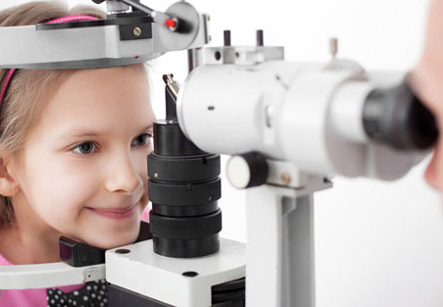Pediatric Ophthalmology
Introduction
Pediatric ophthalmology is a sub-specialty of ophthalmology which deals with eye diseases, visual development, and vision care in children.
Pediatric ophthalmologists need to pursue residency in ophthalmology and are specialized in the eye problems of children. In particular, the vision develops in the brain until the age of 9 years and can be affected by conditions in which eyes are not straight or do not focus correctly. Pediatric eye care is essential as a child can grow up with good vision in each eye if the eye problems are diagnosed and treated early.
Children commonly experience a variety of eye problems and many of these disorders are quite different from adult eye diseases.
All ophthalmologists have training in children’s eye problems. The pediatric ophthalmologist has an additional training and practice in examining children and caring for their eye problems. If the primary care doctor suggests that the child have his or her eyes checked, a pediatric ophthalmologist has the detailed knowledge of the possible conditions and also has experience in examining children effectively.
Iran is now ranking first both in the region and in the Middle East and the Iranian ophthalmology science is among the world top majors

Children commonly experience a variety of eye problems and many of these disorders are quite different from adult eye diseases. Pediatric ophthalmologists are specially trained to manage the following disorders:
1. Infections (conjunctivitis) - infections of cornea, conjunctiva and tissue around the eye (orbit) as well as corneal ulcers are very common in children.
2. Strabismus is a misalignment of the eyes and it is often associated with amblyopia. The inward turning gaze is commonly referred to as “crossed-eyes” or squint. The term strabismus applies to other types of misalignments, including an upward, downward, or outward turning eye. Pediatric ophthalmologists work in conjunction with orthoptists in the treatment of strabismus.
3. Amblyopia is a condition which occurs when the vision of one eye is significantly better than the other eye. The brain begins to rely on the better eye and ignore the weaker one. Amblyopia is clinically diagnosed when the difference between refractive errors of the two eyes is more than 1.5 diopters. The management of amblyopia involves correction of significant refractive errors and using techniques to encourage the brain to pay attention to the weaker eye. This is achieved by patching the stronger eye.(occlusion therapy)
4. Ptosis
5. Blockage of tear ducts
6. Retinopathy of prematurity
7. Nystagmus
8. Visual inattention
9. Cataracts in Pediatric age
10. Pediatric glaucoma
11. Abnormal vision development
12. Genetic disorders which cause eye problems. About 30% of genetic syndromes affect the eyes. Examination by a pediatric ophthalmologist can help in diagnosing these genetic conditions. These conditions need team approach for management. Many pediatric ophthalmologists participate in the multi-disciplinary medical teams that treat children with genetic syndromes.
13. Orbital tumors
14. Congenital malformations affecting vision or the tear drainage duct system can be evaluated and possibly surgically corrected by a pediatric ophthalmologist.
15. Refractive errors in children such as myopia (near-sightedness) and astigmatism can often be corrected with glasses or contact lenses.
16. Insufficiency of accommodation
17. Insufficiency of convergence and asthenopia
18. Evaluation of visual problems in education, including dyslexia and attention deficit hyperactivity disorder.
Examination:
There are various types of examinations performed by pediatric ophthalmologists which include:
1. Vision testing- a particular skill is required to assess the vision of child, particularly before the school age. Different methods need to be used at different ages.
2. Measurement of eye position- this is needed in all patients with misaligned eyes (strabismus)
3. Examining the eye for abnormal structures, evaluating affected parts of the eye, signs of diseases which are affecting the eyes. Examples of systemic diseases affecting the eye are genetic conditions, juvenile rheumatoid arthritis, diabetes. Head and facial injuries can also affect the eye function.
4. Examinations of uncooperative, very young crying children and premature babies are performed.
5. The type and strength of glasses needed for the child at any age can be determined. The focusing ability of the eye is performed (retinoscopy) after drops are instilled in the eye to make the pupils larger.
Treatments in pediatric ophthalmology:
Medical treatments
1. Amblyopia is treated by glasses, patching, and dilating drops.
2. Glasses prescriptions are provided for simple lack of focus such as near-sightedness, astigmatism or farsightedness.
3. Infections such as conjunctivitis, corneal ulcers and the tissue around the eye (orbit) are managed.
4. Inflammation inside the eye from congenital conditions and injuries.
5. Glaucoma and high pressure in the eye can be treated by some pediatric ophthalmologists.
Surgical options for treating pediatric eye conditions include:
1. Eye muscle surgery for misaligned eyes
2. Surgery of blocked tear ducts
3. Cataract surgery for children
4. Repair of eye injuries
5. Some do laser surgery in premature babies, glaucoma surgery, or droopy eye lid surgery (ptosis). This varies with the interest, training, and experience of the pediatric ophthalmologist.